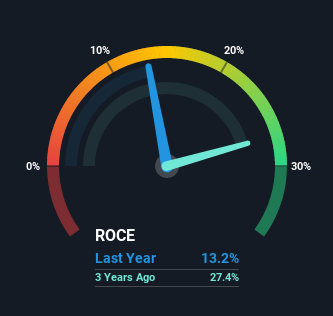- India
- /
- Construction
- /
- NSEI:CEMPRO
ITD Cementation India (NSE:ITDCEM) May Have Issues Allocating Its Capital
What are the early trends we should look for to identify a stock that could multiply in value over the long term? Firstly, we'd want to identify a growing return on capital employed (ROCE) and then alongside that, an ever-increasing base of capital employed. This shows us that it's a compounding machine, able to continually reinvest its earnings back into the business and generate higher returns. Although, when we looked at ITD Cementation India (NSE:ITDCEM), it didn't seem to tick all of these boxes.
Understanding Return On Capital Employed (ROCE)
Just to clarify if you're unsure, ROCE is a metric for evaluating how much pre-tax income (in percentage terms) a company earns on the capital invested in its business. Analysts use this formula to calculate it for ITD Cementation India:
Return on Capital Employed = Earnings Before Interest and Tax (EBIT) ÷ (Total Assets - Current Liabilities)
0.13 = ₹1.6b ÷ (₹32b - ₹20b) (Based on the trailing twelve months to June 2021).
Therefore, ITD Cementation India has an ROCE of 13%. In absolute terms, that's a satisfactory return, but compared to the Construction industry average of 10% it's much better.
View our latest analysis for ITD Cementation India

Above you can see how the current ROCE for ITD Cementation India compares to its prior returns on capital, but there's only so much you can tell from the past. If you'd like to see what analysts are forecasting going forward, you should check out our free report for ITD Cementation India.
What The Trend Of ROCE Can Tell Us
When we looked at the ROCE trend at ITD Cementation India, we didn't gain much confidence. Over the last five years, returns on capital have decreased to 13% from 33% five years ago. Although, given both revenue and the amount of assets employed in the business have increased, it could suggest the company is investing in growth, and the extra capital has led to a short-term reduction in ROCE. If these investments prove successful, this can bode very well for long term stock performance.
On a side note, ITD Cementation India has done well to pay down its current liabilities to 62% of total assets. So we could link some of this to the decrease in ROCE. Effectively this means their suppliers or short-term creditors are funding less of the business, which reduces some elements of risk. Since the business is basically funding more of its operations with it's own money, you could argue this has made the business less efficient at generating ROCE. Either way, they're still at a pretty high level, so we'd like to see them fall further if possible.
What We Can Learn From ITD Cementation India's ROCE
Even though returns on capital have fallen in the short term, we find it promising that revenue and capital employed have both increased for ITD Cementation India. These growth trends haven't led to growth returns though, since the stock has fallen 44% over the last five years. As a result, we'd recommend researching this stock further to uncover what other fundamentals of the business can show us.
While ITD Cementation India doesn't shine too bright in this respect, it's still worth seeing if the company is trading at attractive prices. You can find that out with our FREE intrinsic value estimation on our platform.
While ITD Cementation India may not currently earn the highest returns, we've compiled a list of companies that currently earn more than 25% return on equity. Check out this free list here.
New: AI Stock Screener & Alerts
Our new AI Stock Screener scans the market every day to uncover opportunities.
• Dividend Powerhouses (3%+ Yield)
• Undervalued Small Caps with Insider Buying
• High growth Tech and AI Companies
Or build your own from over 50 metrics.
This article by Simply Wall St is general in nature. We provide commentary based on historical data and analyst forecasts only using an unbiased methodology and our articles are not intended to be financial advice. It does not constitute a recommendation to buy or sell any stock, and does not take account of your objectives, or your financial situation. We aim to bring you long-term focused analysis driven by fundamental data. Note that our analysis may not factor in the latest price-sensitive company announcements or qualitative material. Simply Wall St has no position in any stocks mentioned.
Have feedback on this article? Concerned about the content? Get in touch with us directly. Alternatively, email editorial-team (at) simplywallst.com.
About NSEI:CEMPRO
Cemindia Projects
Provides construction and civil engineering contracting services in India.
Flawless balance sheet with high growth potential.
Similar Companies
Market Insights
Community Narratives




